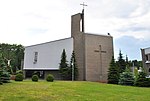Medical University of Silesia
1948 establishments in PolandEducational institutions established in 1948Medical schools in PolandUniversities and colleges in KatowiceUse mdy dates from September 2016
The Medical University of Silesia (Polish: Śląski Uniwersytet Medyczny) is a university located in Katowice, Poland. The university has 10,218 students and a teaching staff of 1201, including 295 professors. There are five faculties: Medicine, Dentistry, Pharmacy, Public Health, Health Sciences (includes degrees in nursing, physical therapy, dietetics). The English divisions in the Faculties of Medicine and Dentistry have 517 and 57 students, respectively
Excerpt from the Wikipedia article Medical University of Silesia (License: CC BY-SA 3.0, Authors).Medical University of Silesia
Medyków, Katowice Panewniki (Ligota-Panewniki)
Geographical coordinates (GPS) Address Phone number Website Nearby Places Show on map
Geographical coordinates (GPS)
| Latitude | Longitude |
|---|---|
| N 50.224955555556 ° | E 18.953669444444 ° |
Address
Śląski Uniwersytet Medyczny Wydział Lekarski
Medyków 18
40-752 Katowice, Panewniki (Ligota-Panewniki)
Silesian Voivodeship, Poland
Open on Google Maps







